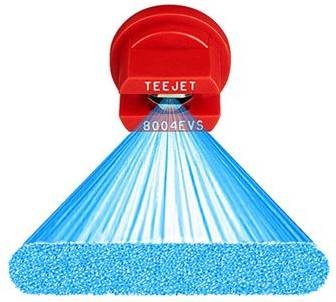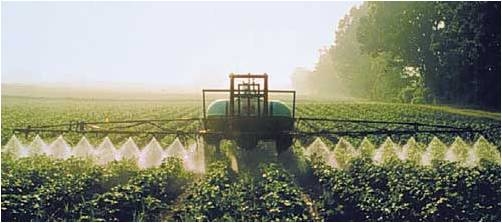Last week I sat in on the Weed Science School at held at UC Davis. This event is held every two years (alternating with the Aquatic Weed School) and is intended as a refresher or high-level introduction to weed science for professionals in the field. I always enjoy sitting in on as many of the lectures as I can because I always learn something (either completely new or previously forgotten!) from my colleagues.
Kurt Hembree (UCCE Weed Science Farm Advisor) led a breakout discussion and demonstration session on the last day of the short course where we talked about the importance of spray nozzles for effective herbicide applications. Kurt used a multi-nozzle spray table with a recirculating water pump to demonstrate the coverage, droplet size, and potential off-target drift that can occur due to nozzle selection. With the flip of a switch and a quick-change nozzle body, we looked at the effect of nozzle orifice size, spray pressure, and nozzle technology (flat fans, turbo fans, twin fans, air induction nozzles) - a very good reminder!
I've talked about nozzle selection and sprayer calibration at a few extension meetings and even in a previous post last fall; however, this is such a key part of effective weed control with herbicides that it bears repeating. A couple of key points for me from Kurt's presentation and from nozzle literature include:
1. Select the right nozzle for the job. This is based on required coverage (contact vs systemic herbicide), operating pressure, ground speed, nozzle spacing, and boom height.
2. Use larger orifice nozzles to increase droplet size and reduce drift. Small droplets can sometimes move a LONG ways.
3. Consider using newer nozzle technology that are capable of more uniform droplet distribution and lower operating pressure to reduce droplets outside of the optimum size.
4. Calibrate frequently and replace nozzles that are more than 5-10% out of the target range. Plugged or worn nozzles reduce efficacy and cost you money in wasted herbicide!

I've attached an extension bulletin from Virgina Cooperative Extension called "Nozzles: Selection and Sizing (Publication 332-032)" that does a good job of explaining common nozzles used in ag sprayers. It is also available here: http://pubs.ext.vt.edu/442/442-032/442-032_pdf.pdf
One of the major spray equipment manufacturers, TeeJet, has excellent information on nozzles that I use often: http://www.teejet.com/media/40076/users%20guide%20final(low).pdf
Finally, the Spray Drift Task Force has information on factors contributing to off-target movement of pesticides: http://www.agdrift.com/
Attached Files:
Attached Images:
